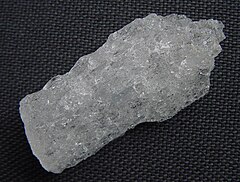Kalinite
| Kalinite | |
|---|---|

Kalinite from the Virgin Valley District, Nevada, USA. Specimen size 5.4 cm
|
|
| General | |
| Category | Sulfate minerals |
|
Formula (repeating unit) |
KAl(SO4)2·11H2O |
| Strunz classification | 7.CC.15 |
| Dana classification | 29.5.4.2 |
| Crystal system | Monoclinic |
| Crystal class | Prismatic (2/m) (same H-M symbol) |
| Space group | C2/c |
| Unit cell | a = 19.92(16), b = 9.27(3) c = 8.304(13) Å β = 98.79(19)°; Z = 4 |
| Identification | |
| Formula mass | 456.37 g/mol |
| Color | White to pale blue |
| Crystal habit | Fibrous |
| Fracture | Conchoidal |
| Mohs scale hardness | 2 to 2.5 |
| Luster | Vitreous |
| Streak | White |
| Diaphaneity | Transparent |
| Specific gravity | 1.75 (observed) 2.0 (calculated) |
| Optical properties | Biaxial (-) |
| Refractive index | nα = 1.429 to 1.430, nβ = 1.452, nγ = 1.456 to 1.458 |
| Birefringence | None |
| 2V angle | 52° (measured), 82° (calculated) |
| Solubility | Soluble in water |
| Other characteristics | Not fluorescent, barely detectable radioactivity |
| References | |
Kalinite is a mineral composed of hydrated potassium aluminium sulfate (a type of alum). It is a fibrous monoclinic alum, distinct from isometric potassium alum, named in 1868. Its name comes from kalium (derived from Arabic: القَلْيَه al-qalyah “plant ashes”) which is the Latin name for potassium, hence its chemical symbol, "K".
A proposal to remove recognition of kalinite as a mineral species is scheduled to be submitted to the International Mineralogical Association, currently (March 2010), kalinite is still on the list of approved minerals. Many older samples, however, have been found to be potassium alum.
Kalinite is a rare secondary mineral observed in the oxidized zone of mineral deposits, as efflorescence on alum slates, in caves, and as a volcanic sublimate. It is associated with jarosite, KFe3+3(SO4)2(OH)6, and cuprian melanterite (pisanite), (Fe2+,Cu2+)SO4·7H2O, at Quetena, Chile.
...
Wikipedia
